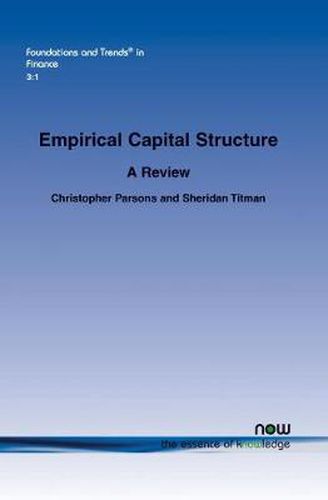Readings Newsletter
Become a Readings Member to make your shopping experience even easier.
Sign in or sign up for free!
You’re not far away from qualifying for FREE standard shipping within Australia
You’ve qualified for FREE standard shipping within Australia
The cart is loading…






This title is printed to order. This book may have been self-published. If so, we cannot guarantee the quality of the content. In the main most books will have gone through the editing process however some may not. We therefore suggest that you be aware of this before ordering this book. If in doubt check either the author or publisher’s details as we are unable to accept any returns unless they are faulty. Please contact us if you have any questions.
The firm’s capital structure - how it funds operations by raising capital from a variety of sources - has attracted considerable attention from both academics and practitioners. The empirical capital structure literature explores both the cross-sectional determinants of capital structure as well as time-series changes. Empirical Capital Structure reviews both aspects of this literature.
The book is organized around a simple framework that contains three key ingredients: the costs and benefits that determine a firm’s capital structure; the existence of shocks that cause firms to deviate, at least temporarily, from their targets; the presence of factors that may prevent firms from constantly maintaining debt ratios that match their targets.
Empirical Capital Structure is organized as follows:
Section II discusses specification and econometric issues that will be important for many of the tests considered. Section III reviews cross-sectional capital structure determinants. Section IV explores factors that pull firms away from their leverage targets. Section V discusses reasons why firms might not immediately reverse the effect of these leverage shocks, apparently allowing deviations from their targets to persist for extended periods of time. Section VI explores a group of studies that look at how leverage feeds back into a firm’s real business decisions. Section VII concludes and provides suggestions for new research.
$9.00 standard shipping within Australia
FREE standard shipping within Australia for orders over $100.00
Express & International shipping calculated at checkout
This title is printed to order. This book may have been self-published. If so, we cannot guarantee the quality of the content. In the main most books will have gone through the editing process however some may not. We therefore suggest that you be aware of this before ordering this book. If in doubt check either the author or publisher’s details as we are unable to accept any returns unless they are faulty. Please contact us if you have any questions.
The firm’s capital structure - how it funds operations by raising capital from a variety of sources - has attracted considerable attention from both academics and practitioners. The empirical capital structure literature explores both the cross-sectional determinants of capital structure as well as time-series changes. Empirical Capital Structure reviews both aspects of this literature.
The book is organized around a simple framework that contains three key ingredients: the costs and benefits that determine a firm’s capital structure; the existence of shocks that cause firms to deviate, at least temporarily, from their targets; the presence of factors that may prevent firms from constantly maintaining debt ratios that match their targets.
Empirical Capital Structure is organized as follows:
Section II discusses specification and econometric issues that will be important for many of the tests considered. Section III reviews cross-sectional capital structure determinants. Section IV explores factors that pull firms away from their leverage targets. Section V discusses reasons why firms might not immediately reverse the effect of these leverage shocks, apparently allowing deviations from their targets to persist for extended periods of time. Section VI explores a group of studies that look at how leverage feeds back into a firm’s real business decisions. Section VII concludes and provides suggestions for new research.